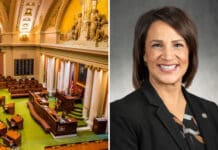Imagine having to travel to Iowa to see your primary care doctor or South Dakota to get your knee replaced. This is similar to what many Canadians do when they come to the USA to get care because their “cheap,” low-cost national health plan has resulted in a shortage of doctors. Wait times and shortages are common — and coming to Minnesota soon.
DFL House and Senate members, while ignoring the Republican attempts to amend it, are about to settle on a new health reform bill hidden inside of a massive health and human services omnibus bill. A conference committee will soon move forward on the bill. Once the House and Senate hammer out their differences, the DFL legislators, without any floor amendments allowed, will pass it. After Gov. Tim Walz signs it and it is enshrined in Minnesota statute, it will be nearly impossible to change.
Quality, access, affordability
Patients want access to quality health care at affordable prices — or for many, at no cost to them. Health care reformers understand this, to which they say, “pick any two.”
The reality is that meddling with quality to save money can reduce access to care. Increasing access to more care and more folks can reduce quality as providers are spread thin. Using government or even insurance company pressure to force lower prices on providers results in a loss of access to care and inevitably a reduction in quality.
DFL wants to solve this dilemma
The DFL-led Minnesota government is determined to “fix” health care. Finally in control of Minnesota government, they are poised to give us what they think we want. This is their latest step toward government-controlled health care, a DFL goal for decades.
Under the guise of a “public option” health plan and at the direction of new government agencies, the DFL bill will affect all health care services, changing how it is delivered and how we Minnesotans will pay for it. The DFL sincerely believes their reform is necessary and good. Those who lose access to health care and the medical providers who watch their income drop once the bill’s effects become more evident will disagree.
Everyone eligible
The bill expands access to MinnesotaCare with a public option health plan available to essentially everyone. Under the current law, one must be a citizen of the United States to enroll in MinnesotaCare, but the new DFL public option plan changes that. Citizens of Minnesota will fight for access to care with non-citizen residents who are here legally or illegally.
It is predictable that when non-citizens enroll in the public option plan, or other government-sponsored health care, they will put pressure on providers and crowd out those who pay insurance premiums and the taxes to subsidize their new health insurance plans.
Under the new DFL plan, individuals younger than 21 will receive coverage for free. “Free” is an interesting word when it involves government-subsidized entities. Someone pays — called taxpayers or private insurance premium payers.
Excepted from MinnesotaCare enrollment are very low-income individuals who will be put on Medical Assistance, government employees who will be allowed to retain their private, taxpayer-paid health plan options, and groups or individuals who opt for private insurance — at far greater cost than today.
If your highest priority for health care reform is the ability to access a doctor, or receive care in state-of-the-art medical facilities, or timely choices for surgical interventions, soon after 2026, when the DFL plan fully kicks in, you will be greatly disappointed.
When prices are reduced in the way the public option does it, access will fall. That is because the new public option pays providers based on the MinnesotaCare fee-for-service scale. It is less than what Medicare allows, and few if any medical providers can survive on today’s Medicare level of payment.
Think about this. If a doctor cannot break even receiving $100 to see a Medicare patient, how does that doctor compensate today? The data shows that today, on average, people with private insurance will pay the doctor $201. What will happen when those with MinnesotaCare show up and the doctor knows he or she will only receive $80? And when more people show up for their $80 care than do today, what will the doctor do? Other than raise the prices for privately insured patients, it might be time to retire or move.
Doctors and facilities already either outright refuse to see Medicaid and Medicare patients, or find a way around requirements to do so by making only a few appointments available. “Only about 63% of doctors practicing internal medicine accept Medicaid, compared to 99% acceptance of private plans,” wrote Ross Marchand. MinnesotaCare pays slightly more than Medicaid, but less than Medicare.
The new, expanded MinnesotaCare public option, unlike Canada’s nationalized medical system, will cover dental, vision, and hearing care. The DFL believes that in Minnesota we will be able to get more for less. What Canada cannot afford to provide in their plan we will do — somehow.
How do you get more for less? Well, you get less. Why? Because medical professionals will not enjoy seeing their payments reduced while at the same time seeing an increase in the number of patients.
When government pays less, private payers pay more — much more. “The increase in cost is paid for by working people, in the form of higher taxes to fund the premium subsidies. They and their employers also pay increasingly more expensive insurance premiums. Either way, working people pay more so that others can pay less with a government subsidy.”
The higher cost to those with private insurance acts like a tax, though hidden from those who pay its increasingly-unaffordable premiums. Eventually the dam will break, and those with private insurance will flee to the public option, driving provider reimbursements far lower, and more of them out of practice (or out of Minnesota).
Plainly said, the DFL public option saves money at least in part by paying providers less than they receive today from privately insured patients. This is a disincentive to practice medicine in Minnesota or invest in or maintain facilities.
The state public option will appear to be a great value to premium payers. It offers enrollment in a “Platinum” level plan priced far less than the cheapest private health plan. Sounds like a value? It would be if you are actually able to gain access to a willing provider, many of whom will find a different profession or move to a state where they can afford to practice.
Ready for prime time in 2027
If all goes as planned by the DFL, your new, cheaper public option health plan that reduces access to care, although at a dramatically lower price, should be ready for prime time by January of 2027.
The fact that the government commissions will begin to study options in July 2023, and report in January 2025, means providers will begin to adapt to its expected changes earlier on. Many of the concerning effects will have been felt by the first open enrollment period in 2027.
ObamaCare resulted in the Republicans taking over Congress. It is likely the Republicans will take over the Minnesota Legislature in 2025 once the public understands the new public option plan and how it will affect health care. It will be too late. Gov. Walz will continue to backstop this new law, as President Obama did with ObamaCare. Without substantial public pressure, it is likely its worst effects cannot be undone until late in this decade.
















